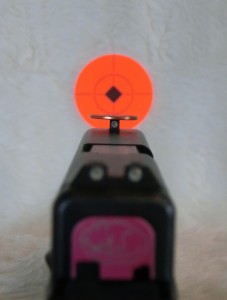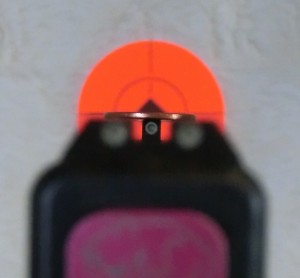The question:
A friend asked me what kind of gun she should get. …Don’t worry: I know not to choose a gun for someone else. That’s not my question today.
My concern is that I know she doesn’t understand the depth of what she’s asking. I’m terrified of her buying a rabbit’s-foot gun (She also said “I don’t want to really kill someone”) and being in more danger from the false sense of security.
But I also don’t want to tell her that she has to study and train until she’s as good as Kathy Jackson before she should consider carrying. At least, I hope she doesn’t: I’m certainly not where I’d like to be yet, but I consider carry to be right for me.
How best to emphasize the serious responsibility of CCW while still encouraging a newbie?
My response: Wow, you just said a mouthful! I started to answer this on Facebook (where it was asked), then realized it was going to take a lot more words than fit easily into the Fb format. So here we are.
There are several issues here, some thornier than others. Listed from easiest to hardest to answer, the questions I see are:
- What kind of gun do you recommend to a newbie? (Thanks for letting me off the hook on answering this one – that makes it the easiest question in your note!) 😉
- How much training is ‘enough’ for someone who wants to carry a gun?
- How can I tell if my friend understands that carrying a gun is a serious decision? And how can I help my friend take that decision seriously, if she doesn’t already?
Skipping over question 1), which you mercifully allowed me to ignore, let’s take a look at the remaining two issues.
How much training is ‘enough’?
Yes, I know you didn’t ask the question in those words. (Thanks for letting me play off your ideas, though!) What you did say was, “But I also don’t want to tell her that she has to study and train until she’s as good as Kathy Jackson before she should consider carrying…”
Here’s a secret: Kathy Jackson wasn’t as good as Kathy Jackson when she first started carrying. The ugly truth is that I have absolutely no natural talent for physical skills, and shooting is a physical skill. You know that old saw about how women are “naturally” good at fine-motor skills, like pressing the trigger smoothly? You couldn’t prove it by me. In fact, the way I ended up taking any shooting classes at all was because a friend of ours used to build his own homemade target stands and take us out to shoot with him. One day, after several months of him doing everything he could to help me, he finally got fed up with me shooting the legs off his target stands (and the dirt in front of them) and told me I had to go take a class. “I’ve done all I can do for you,” was how he charitably put it.
He was right.
Despite the fact that I was such a bad shooter, I had already begun carrying my pistol by then. Should I have? Well… yes. Make that a qualified yes, because I already had the mindset for it. What I didn’t have were the knowledge and the skills I have now. So carrying the gun at that point was the right decision for me, but it might not be the right decision for someone else.
A gun you have with you works a lot better to defend yourself with than a gun you don’t have with you. Of course, the only criminal problem I could have solved at that point was one where the bad guy got so close to me that I couldn’t possibly miss him. Or (even better) the kind where the bad guy went running away as soon as he saw that I was armed. Since good people defend themselves in exactly that way at least a million times a year in this country, with the bad guy running away without a single shot being fired, I feel comfortable saying that even if you’re a poor shooter, you’re better off defending yourself with a gun than without one.
But.
The real question is, should I have stayed at that level of skill, where I couldn’t reliably hit a non-moving piece of cardboard from five steps away? Um, no. That would have been a bad plan. For one thing, even though most defensive gun uses end with no shots fired, just with the good guy showing the bad guy that he chose the wrong victim by showing him the gun, that doesn’t mean all defensive gun uses end that way. Quite a lot of them end up with the good guy needing to, you know, actually hit the bad guy with a bullet or six. That being the case, it’s better if you can put the bullet exactly where you intend to put it, and not hit somewhere, something, or someone else.
One more caveat: Carrying a gun when I didn’t have the skills to do much with it yet was the right decision for me, but it may not have been the best decision for my family or anyone else I cared about, because I really didn’t have the skills to help anyone else. Criminals don’t just attack people who are alone. Sometimes they attack people who are with other people, with loved ones and friends. Sometimes they attack the family member across the room from you, and if you don’t have the skills to stop the bad guy without hitting your own husband or child, you’re going to be in a world of hurt.
With all that in mind, having the mindset and skill to stop a single, not-too-smart attacker at point-blank range is all you need in order to make the decision to start carrying. But it’s not a good place to stop.
(At this point, you’re probably wondering, “Uhhhh, so how much training and knowledge is ‘enough’, then?” That’s actually a trick question. There’s no real answer. That’s because making the decision to protect yourself is a lifestyle change – a journey rather than a destination. Start where you are, learn more as you go along. Be free.)
It’s serious – but does she know that?
Knowing you, I know you’re already doing most of the right things as you talk to your friend. You listen. You ask questions. You give thoughtful answers when she asks questions. All of the things that make pleasant, useful conversations and interactions between people, you’re already doing. Good for you! Those listening and feedback skills are exactly the skills that help you figure out what she needs to know next, and how to help her find it successfully.
So let’s move on to what you really asked: How best to emphasize the serious responsibility of CCW while still encouraging a newbie?
Choosing to carry a gun is serious business. You know this, I know this, and we want everyone who carries a gun to know it too.
The decision to arm yourself with lethal force is not for the squeamish or for the faint of heart. It does require a definite, ongoing commitment to safe behavior around a deadly weapon. It requires some honest soul-searching: are you really willing to use this thing if you have to? You have to face some deeply personal questions about your ethical and moral choices, and know that similar questions will keep coming up for as long as it takes for you to process this lifestyle change. You’re making a decision to learn a little about the law, a little about crime, a little about self-defense, and a lot about human nature including your own. And if you’re smart, you realize that you’ll need to learn how to physically use the firearm, first the fundamentals and then how to apply those fundamentals to different situations, and that you’ll need to keep your learning up to date as time goes on.
None of those are minor things… and they are all absolutely frightening to process all at once. Please don’t drop everything you know about carrying a gun on your friend, all at once, in one big terrifying package. It’s not necessary and it’s not fair. She only needs to take the next step, then decide if that step was the direction she wanted to go, before she takes the one after that. And she gets to decide how big each step will be, or whether she’ll take the next one. Your job is simply to be a friend and offer her opportunities to learn more as she’s ready for them.
One thing you can do, if you haven’t done it already, is to download a copy of Marty Hayes’ excellent booklet What Every Gun Owner Needs to Know About Self-Defense Law. It’s available free from the Armed Citizens’ Legal Defense Network as their outreach to the defensive firearms community. You can also order the same material as a (free) physical booklet from the same source. This little booklet provides a lot of very good information in a quick, easy-to-read format. There’s just enough there to get a newcomer pointed in the right direction, without scaring them too badly about the whole thing.
Not to toot my own horn or anything, but I did write a book about this stuff … and Christmas is coming. If you think your friend is ready for it, you might want to pop on over to Amazon and pick up a copy of The Cornered Cat: A Woman’s Guide to Concealed Carry. The nice thing about it being in book form is that she can put it in her bathroom, or on her nightstand, and just read a tiny little bit whenever she’s ready for it. Or skim through to find the parts she cares about. She doesn’t have to process everything at once, but the book itself can serve as a kind of physical reminder that she can learn more if she wants.
Another idea: if there’s a women’s shooting club in your area, such as the wonderful A Girl and A Gun clubs, you might invite her to join you for a Girl’s Night Out or other events. Within that very supportive and welcoming format, you’ll both make some new friends and will have the chance to learn more about gun ownership in a friendly, low-key kind of way.
If your friend does decide to move ahead with firearms ownership and wants to learn even more, you could invite her to take a class with you. Whether you’ve taken one before or not, it never hurts to refresh the fundamentals for yourself, and it’s always more fun to shoot with a friend. Perhaps you can even get a group of friends together to do the same thing, because after the class you will have a lot to talk about, and it’s wonderfully refreshing to have friends you can process things with who understand exactly where you’re coming from.
Bottom line
Be a good friend. Listen. Ask questions. Offer opportunities. Enjoy the journey.








